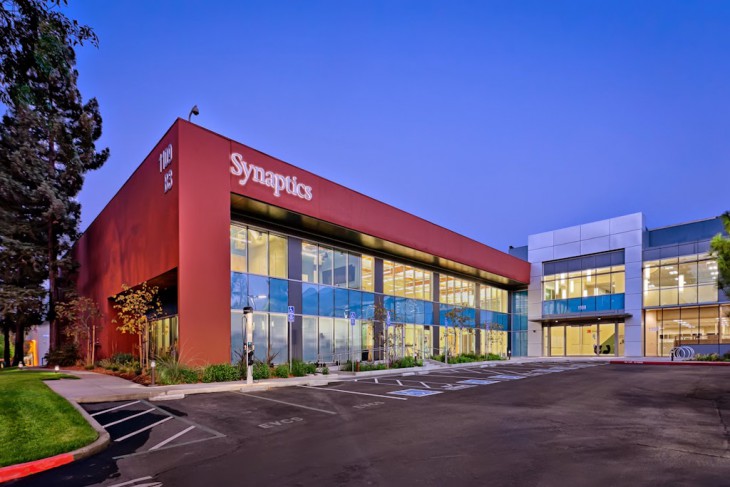
Synaptics, a name some of us who’ve been around a while would usually associate with trackpads on laptops, is in Android news today, announcing its new ClearPad 3700 force-sensing touchscreen controller, which the company would like to see in 2016’s Android phones. This technology would allow devices to offer the same kind of functionality as in the new range of iPhones with their 3D Touch feature.
For those unfamiliar, a pressure-sensitive touchscreen allows an operating system to discern between a normal touch, which would be interpreted as a tap on a non-pressure screen, and a more deliberate press, which could activate ‘right click’ type functionality, for example. One feature in the new iOS which uses this well is the touchpad that activates when pressing firmly on the keyboard area, allowing for more precise cursor movement when navigating text.
This is just one possible feature, with others including new ways to zoom and pan over pictures and web pages, contextual menu activation, and even variable speed scrolling depending on how hard you push.
However, with no support for pressure-sensitive screens in Android at present, this will rely on OEMs coming up with their own solutions — something that always ends up with a consistent user experience — until Google recognises the momentum and implements it as a key operating system function.
[showhide]
SAN JOSE, Calif., Oct. 6, 2015 /PRNewswire/ — Synaptics Inc. (NASDAQ: SYNA), the leading developer of human interface solutions, today announced three new series of ClearPad® discrete touch controller solutions, enabling increased functionality and entirely new dimensions of touch, including force sensing for smartphones, tablets and automotive applications. This latest expansion of the ClearPad portfolio further demonstrates Synaptics’ technology leadership in discrete touch solutions, giving OEMs the ability to deliver the most innovative user experience to consumers.
“Our broad patent portfolio and years of proven experience in touch technology has once again enabled us to provide smartphone OEMs and LCMs with cutting-edge user experience solutions,” said Kevin Barber, senior vice president, general manager, Smart Display Division, Synaptics. “The latest ClearPad family of products extends into multiple market segments with exciting new functionality and underscores Synaptics’ innovation and leadership in creating unmatched touch solutions.”
Synaptics 3700 Series:
- Latest flagship discrete touch controller for smartphones
- Supports new technologies including ClearForce variable force sensing, and SideTouch™ for edge gesturing such as scroll and tap — as featured in the new Xiaomi Mi4c
- Massive performance upgrade, doubling MIPS and memory over its predecessor to enable advanced features
- Supports unique active and passive stylus capabilities as well as non-touch hover performance at distances up to 25mm
Synaptics 3600 Series:
- Optimized for mainstream smartphones
- New silicon architecture for improved touch performance
- Supports new features without additional cost, including enhanced gloved touch, two finger tracking with moisture on display, multiple user-defined gesture recognition, and FaceDetect™ Plus, eliminating the need for a proximity sensor
Synaptics 7800 Series:
- Optimized for large touch screens up to 17.3 inches, including notebooks, tablets and automotive applications
- Processing power that doubles previous generation large touch screen controllers, enabling advanced features and performance needed for larger smart devices
- Features 1mm passive pen support and excellent palm rejection performance
- Advanced moisture and glove performance as well as low power wake-up gestures enhance user experience
Availability:
ClearPad 3700 and 7800 series are both currently in mass production. ClearPad 3600 series is broadly sampling with mass production slated for Q4 2015.
[/showhide]





Time will tell if this ends up being a thing, but if it does, I hope it is baked into the next version of Android so there is some consistency.
Redundant marketing hype. I’d rather just long press for a menu like we currently can. Turn the long press delay down if you feel it takes too long. Fancier screens mean less battery space (refer the iPhone 6s) and potentially more drain.
I think it paves the way for more creative use of the short vs long tap, and it certainly makes that detection more precise and less of a blunt instrument; e.g. long press on text brings up various context sensitive menus depending on OEM, but a firm press could bring up something else, for example.
Not sure if we need that … but selecting/editing blocks of text on Android can be rather annoying.
Matias Duarte has talked about the problems with the long press – hard to discover and can lead to frustrations with inconsistency vs expectations. It could be a similar experience with the “force touch”, though I’d agree with you it “makes that detection more precise and less of a blunt instrument”.
I should say that’s why the long press has been largely designed out of Android since Holo.